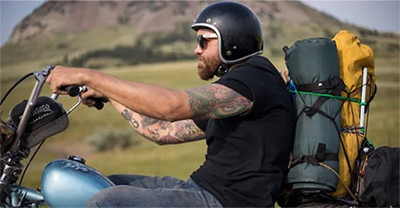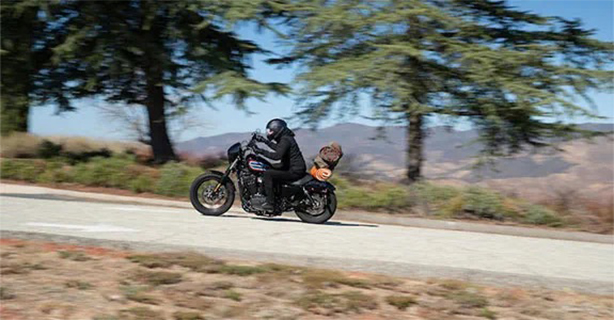Riding a motorcycle safely in high winds involves preparation and knowledge. By following these guidelines, you can turn a potentially challenging ride into an enjoyable adventure.
Wind.
In its many pleasant forms, we riders generally consider it our friend.
We relish feeling the “wind in our faces.” Riding a motorcycle in the wind carries the scents, good and bad, that make riding an extra-dimensional experience. We describe ourselves as “brothers and sisters in the wind.” When the sun is high and hot, it's our natural air conditioner, carrying heat away from our bodies (and engines) as we ride toward the inevitable sunset.
These and other wind-aided scenarios help distinguish our travel experience from that of the cage-dwelling driver.
But wind also has a treacherous side.
WHAT AFFECTS A BIKE IN STRONG WINDS?
When wind gusts unpredictably, barrels across the wide-open spaces we love so much, and blasts like jet wash over a high bridge, we suddenly find ourselves cursing our constant traveling companion. Sometimes we have a choice about riding when the wind whips up.
Sometimes we don't (though in truth, we always really do. Consider waiting for better conditions if you are not comfortable). But whatever the circumstances, knowing how to prepare for and react to the challenges high winds present is key to enjoying the ride.
Or, as the case may be, simply enduring it.
Motorcycle Model Behavior
One of the most basic things that can affect your ride in the wind is simply your choice of motorcycle.
Now, we're not about to suggest that you choose your ride based on how well it handles the wind. But knowing how that choice may affect you in certain situations can help you prepare for them.
Generally speaking, all Harley-Davidson® motorcycles handle exceptionally well in windy conditions. For one thing, they're “heavyweight” motorcycles, which helps anchor them against the force of an intense blast. And their powerful engines give you an edge when you find yourself riding straight into the teeth of the wind’s resistance.
Key Takeaway: Choose a heavier bike if you frequently ride in windy conditions. Heavier motorcycles can handle windy conditions better.
Motorcycle Riding Position
However, riding position can make a difference, as well – for better or worse. For instance, a classic “cruiser” riding position does not provide the same control as a more upright position. And on windy days, “ape-hanger” handlebars may just give you fits. Features such as solid wheels can also affect handling.
Let's be clear: I'm not suggesting any of these things are bad. They're just things to think about when battling the breeze.
Key Takeaway: An upright riding position offers better control. Adjust your posture to improve handling in high winds.
Motorcycle Packing
How you pack your bike can have a big effect, as well so it is vital to follow the owner’s manual for loading your motorcycle. In his book, Proficient Motorcycling, author David L. Hough talks about “sails” – that is, parts of your motorcycle that are particularly prone to catching the wind and pushing it around the road.
A particularly “effective” sail is that big touring pack riders often strap to their passenger pillion or luggage rack. Because these are often mounted so high, so far above the motorcycle's center of gravity, the wind gets a lot of leverage as it slams into the side of the pack. (Riding with a passenger has a similar effect.)
Key Takeaway: If the weather forecast predicts a windy ride, avoid packing tall or wide luggage. Keep your load low and balanced.
Motorcycle Windshields
Another sail is the windshield or fairing on your motorcycle. These popular accessories can be something of a double-edged sword when it comes to wind. On most days, or when you're riding directly into a headwind, windshields and fairings do exactly what they're supposed to: shield you from the wind. In high crosswind situations, however, they can work against you.
It can also make a difference in crosswinds whether the fairing is fork mounted or frame-mounted. When crosswinds hit a frame-mounted fairing, the effect is to push the bike downwind. However, with a fork-mounted fairing, the wind can turn the bars and create a countersteering effect, which can turn you slightly into the wind. (We'll discuss this more later.)
The difference may not be dramatic, but again, the bottom line is to know what you're dealing with. Because in riding, as in life, knowledge is power.
Key Takeaway: Consider the type of windshield or fairing you use and how it affects handling in windy conditions.
HOW TO ACT AND REACT TO WINDY WEATHER CONDITIONS
The more you study safe riding practices, the more certain themes keep emerging. In the case of high winds, as in almost any riding situation, one of the most important things you can do is anticipate. Be ready for that wind gust before it knocks you into the next lane.
Anticipate Sudden Gusty Wind
Look for visual clues such as swaying trees or flag. Sometimes, a sign of coming wind can be quite literal: a sign on a bridge warning of “STRONG CROSSWINDS.” More often, however, they're more subtle:
You're riding down into a wide valley and see the trees and bushes ahead swaying.
You're cresting a mountain pass and know from experience that the winds may pick up on the other side.
You see dark clouds up ahead or a foreboding change in the cloud pattern.
Maybe you can just feel the wind start to pick up.
Anticipate Heavy Crosswind
Be prepared for gusts when passing large vehicles or emerging from tunnels. When you ride under an overpass or pass a semi, be prepared for the crosswind to stop suddenly – and to increase again suddenly when you've completed the pass or passed completely under the road.
No matter the situation, knowing how to react – before you have to – is what's important.
Adjust Riding Position
For starters, adjust your riding position as needed when encountering high wind speeds. As discussed, a laid-back position is less than ideal, so sit up and lean forward a little bit if you can to reduce wind resistance. A slight bend in the elbows will help you better respond to steering inputs created by the wind by absorbing the wind’s force.
Countersteering
A common reaction to a big gust is to clamp onto your handlebar with a tight grip, but this is counterproductive. Maintain a firm but flexible grip on the bars and prepare to lean into the wind as it hits. This is done by countersteering.
A quick review is in order here. “Countersteering” is the process by which all riders turn their motorcycles at speed – whether they realize it or not. To turn the bike to the right, pressure is applied to the right handgrip, which initiates a rightward lean, turning the motorcycle. To lean/turn left, apply pressure to the left handgrip.
Many motorcyclists countersteer naturally without necessarily understanding it, but it's especially important to understand what you're doing in special situations. When blasted with a sudden crosswind, an inexperienced rider's initial, instinctive reaction may be to turn the bars into the wind.
The problem is, this will produce the opposite of the intended reaction. Instead, to countersteer against strong gusts of wind you should apply pressure to the “upwind” handgrip, as firmly and as often as needed, to keep the bike pointed straight down the road in a strong side wind. Keep your body as relaxed as possible and make smooth, firm steering inputs. Don't jerk the bars.
Pay Attention to Safety Zones
It also becomes especially important to pay attention to your lane position and “safety zones” in these situations. Stay as far away as you can from other traffic. On a four-lane road, stay in the upwind lane if possible and try to keep open space to the downwind side, in case you're unexpectedly pushed across the road.
WHAT MOTORCYCLE GEAR IS BEST FOR WINDY CONDITIONS?
Finally, wearing the proper bike gear will take some of the sting out of your windy ride, perhaps literally.
Motorcycle Eye Protection
For starters, make sure you're wearing the best eye protection you can, as windy conditions kick up a lot of debris.
If you do not have a full face helmet with a face shield, consider wearing a bandana or face mask to cover your mouth and nose in high winds. This will not just help protect you from blowing debris but also will make it easier to breathe.
Packing some eye drops and earplugs for the wind noise is also not a bad idea.
Cover Your Skin
Covering your skin completely – with a jacket or long-sleeved shirt – will help protect you from blowing debris and help your body retain moisture. High winds and bare skin provide a quicker path to dehydration, so consider stopping more frequently than usual for water. And keep everything zipped and buttoned to keep things from flapping in the breeze.
BOTTOM LINE ON RIDING A MOTORCYCLE IN WIND
But remember: Riding a motorcycle as safely as possible is all about reducing, not eliminating, risk.
By taking a few simple precautions, and arming yourself with as much knowledge as possible, riding in high winds can be looked at as just one more adventure you encounter on the road instead of something that might ruin your ride.

Riding in a group presents special challenges. These basic guidelines and group riding tips can help make sure your next outing is safe and enjoyable for all.

“America the Beautiful”–there’s no better way to see that beauty than by riding the USA’s roads during a motorcycle event or rally. Get the full list here.

Being on the road when the weather turns wet is all about understanding the needed adjustments. These six wet weather tips will keep the fun going. Learn more!

Ready, Set, Stop! Discover everything you need to know about motorcycle braking techniques to master this skill and reduce your risk while on the open road.



